Some people fear spiders. But, their attitudes might change if they knew that spiders are a great pest control. They help to keep the world free of pests and disease.
Spiders eat many disease-carrying bugs like fleas, flies, roaches, and mosquitos.
A few species grow large enough to eat mice too. This is another animal that commonly carries diseases that can be harmful to humans.
Spiders decrease the insect and mice populations in the areas they inhabit.
In this article, we cover what do spiders eat and talk about feeding them. We also share how they hunt and the diets of a few species in detail.
What Do Spiders Eat?
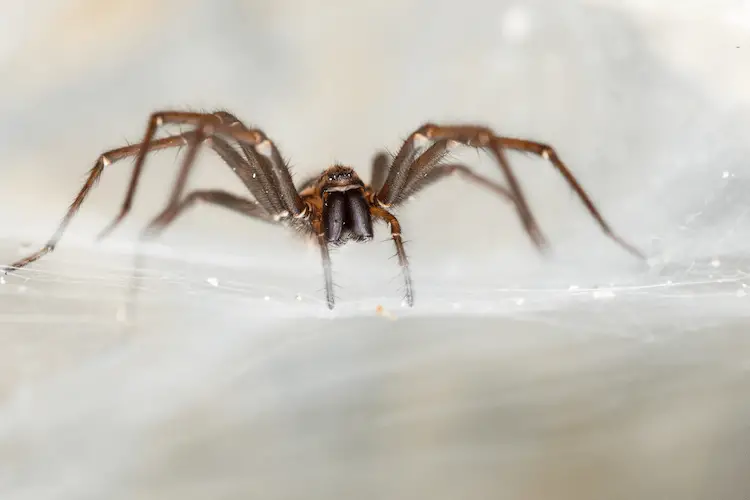
Spiders in the wild eat a variety of different bugs, moths and butterflies. Larger species also eat small birds, amphibians, lizards and small reptiles. There have also been rare cases of a huntsman spider eating a pygmy possum!
The bugs that spiders eat include:
- Crickets
- Grasshoppers
- Roaches
- Flies
- Earwigs
- Mosquitos
- Fleas
- Ants
- Locusts
- Silverfish
- Bees
- Wasp
- Hornets
- Gnats
House spiders eat everything wild species do. But, their diet will usually consist of more fleas, ants, flies, roaches, and earwigs. These smaller bugs are commonly found in households.
This is a big part of why having them in your house is a good thing. They can significantly reduce your risk of getting sick from pests like fleas, flies, and roaches that can carry diseases.
They usually hunt by building webs out of silk they produce from glands in their abdomen.
These webs are incredibly strong and sticky.
Depending on the species, they usually either build webs between plant branches or on the ground using long blades of grass as anchoring points. These webs are hard to see unless they catch the light at a certain angle. Insects will fly into the webbing and become stuck.
One common myth is that spiders only suck the juices from their prey. However, this is not true.
When a spider senses vibrations through the web they will crawl up and bite the prey. After they bite it they will wrap the prey in a silk cocoon and wait for it to die. Finally, they will vomit digestive juices onto it and eat it. The digestive juices break down the prey into a partial liquid as they cannot really chew.
Not all species hunt using webs, though.
Spiders have some of the most interesting hunting tactics of any species.
Some species that live in the house hunt by lying and waiting. They then pounce and inject it with venom. Wolf and jumping spiders are both known to chase after their prey and use their superior speed and athleticism to catch it.
Wolf, jumping, and house spiders are pretty common inside houses, so we will discuss their diets in more detail.
What Do House Spiders Eat?
House spiders, like jumping and wolf spiders, normally eat crickets, cockroaches, flies, gnats, earwigs, mosquitos, fleas, moths, ants, and mayflies. They are fantastic pest control.
Their bites are usually harmless to humans, but not to the bugs that they hunt.
Before you feed spiders in your house, though, be sure you identify them as a species that is not harmful to humans. Brown recluses and black widows are commonly found in houses, especially basements. Both of these species have venom that can be very dangerous and can even kill humans.
Many people like to keep house spiders as pets.
If you are keeping a house spider as a pet, you can feed them a variety of foods:
- Crickets
- Flightless Fruit Flies
- Mealworms
- Small Caterpillars
- Roaches
While spiders inside your house are capable of eating most of the same prey as wild species, their diets are limited to smaller bugs like cockroaches, fleas, gnats, and flies.
If you manage to find small bugs in your house, you can gently place them on their web too. You can also offer anything you would feed to a pet spider, such as crickets, mealworms, flightless fruit flies, and roaches.
A wild-caught species is fine to be fed wild-caught prey. But, if your spider was purchased from a pet store, you should only feed insects or bugs from the pet store.
House spiders hunt both by spinning webs and by actively pursuing their prey.
The cobwebs you find in your house are usually spun by common house spiders trying to catch a meal.
Since we usually remove any cobwebs we find in our houses, web-building spiders have a harder time surviving.
What Do Wolf Spiders Eat?
Wolf spiders are one of the biggest species to live in a house.
Generally they eat a large variety of insects, including: cockroaches, beetles, flies, crickets, grasshoppers, locusts, earwigs, and ants.
Their diet will vary depending on where they inhabit. However, like almost every other species, they are carnivorous.
Wolf species get their name from how they hunt. They are very quick, and they use their speed to chase down their prey.
What Do Jumping Spiders Eat?
Jumping spiders are generally a very small species, reaching only 2cm when they are fully grown.
They will eat any insects or spiders that are about their size or smaller. Their diet consists mostly of gnats, flies, crickets and fleas.
Some larger jumping species have been known to attack and eat small frogs or lizards.
These spiders do not use webs to hunt, instead, they rely upon their amazing jumping ability. They can jump up to 50 times their own body length. To hunt, they launch themselves at their prey and inject them with venom.
How Often Do Spiders Eat?
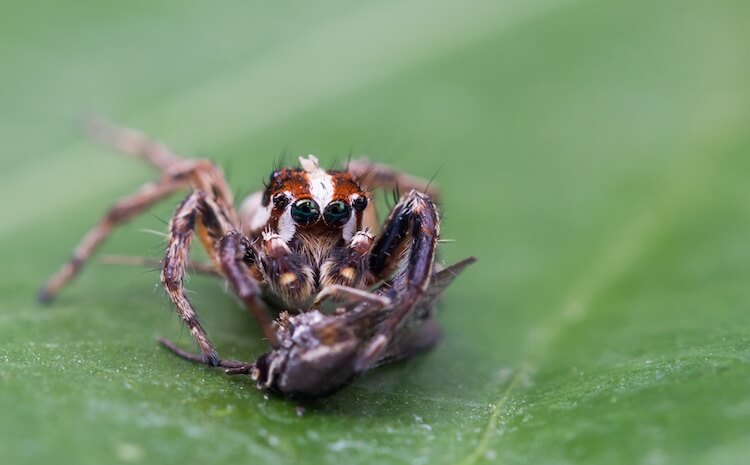
Spiders eat every one to three days. This will depend on the species and how much prey and food is available in their habitat. They are opportunistic feeders, meaning they usually will eat whatever they can, whenever they can.
Animals in the wild have different feeding behaviors than pets
Pet spiders have their humans to feed them, and they can very quickly learn what times of day you normally offer them food. Because of this, they do not feel the need to move around their enclosures as much to hunt. They know that they don’t have to waste time hunting or foraging for food.
Wild animals do not have the same luxury.
They do not know when they might have another chance to eat, so if an opportunity to hunt presents itself, they will take it.
Spiders will not usually ignore a fly that has been trapped in their web. This is food that will require almost no energy to catch beyond what the energy it took to make the web, so they will eat it.
Surprisingly, they are capable of going 30 days without food. This number varies from species to species with Black Widows and Tarantulas being able to survive the longest.
Because they can go so long without food, they do not have to eat every day.
Large species may go a few days between meals, especially if they catch a large prey like a mouse.
Small spiders will usually eat every day if they can. They have much higher metabolisms, meaning their body needs more energy.
Feeding Spiders
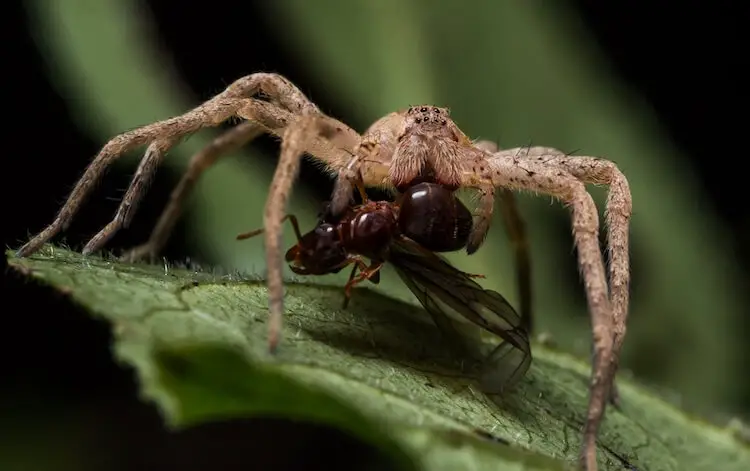
They can eat a wide variety of foods, but a spider’s diet is usually carnivorous.
There is one species that mostly eats plants, called the Bagheera kiplingi jumping spider, but no other omnivorous or herbivorous spiders have been discovered yet.
Normally they eat other animals like insects and bugs.
Below we have compiled a list of some of the most popular questions asked about a spider’s diet.
Can Spiders Eat Birds?
The goliath bird eater is one species famous for eating birds. As its name implies, this spider is known for feeding on birds.
Goliath bird eaters catch birds by ambushing them and injecting them with venom to subdue them.
The Huntsman, another giant species, is also known for eating birds.
There are some huntsman spiders that have a leg length of about 12 inches. They catch birds just like goliath eaters, by hunting them down and injecting them with venom.
Can Spiders Eat Fruit?
No, they are not capable of chewing and their bodies are designed to digest meat.
The Bhageera kiplingi is the only species known to eat plant matter, and even they do not eat fruit. All other spiders eat meat. Even if they were capable of eating fruit, they would not.
Fruit does not have any nutrients that a spider needs.
Can Spiders Eat Wasps?
Spiders are very capable of eating wasps and are known to do so. If a wasp is stuck in their web, they will eat it.
Orb weavers eat wasps very frequently. It is much easier for them to catch a flying insect in their web than by chasing after it.
Can Spiders Eat Human Food?
Human food is usually seasoned with different spices and cooked in butter or oil, all of which can be very harmful to spiders.
Also, most species are not really capable of chewing their food.
They vomit digestive juices onto their food to start to liquefy the flesh, which they then slurp up. They cannot really chew. Because of this, even if the food was unseasoned, they would not be able to eat it.
Can Spiders Eat Ants?
Ants are a staple of many spiders’ diets. Orb weavers, brown recluses, black widows, jumping and wolf spiders all eat ants. Ants are small enough that even small species can eat them. They also do not pose a threat, which makes them less risky to hunt.
Can Spiders Eat Worms?
Most spiders eat smaller invertebrates, but a few larger species are capable of eating worms.
Wandering spiders are known to regularly eat earthworms.
Many species do not have venom powerful enough to effectively kill a worm. Worms are big, so it would take a very potent venom or a large amount of venom to kill one.
Can Spiders Eat Vegetables?
There is only one species of spider that is known to eat vegetables.
The Bhaggera kiplingi, which is a species of jumping spider, eats a mostly herbivorous diet. They are known to eat acacia leaves, nectar, and other parts of the plant. They do eat some insects, but the majority of their diet is vegetation and vegetables.
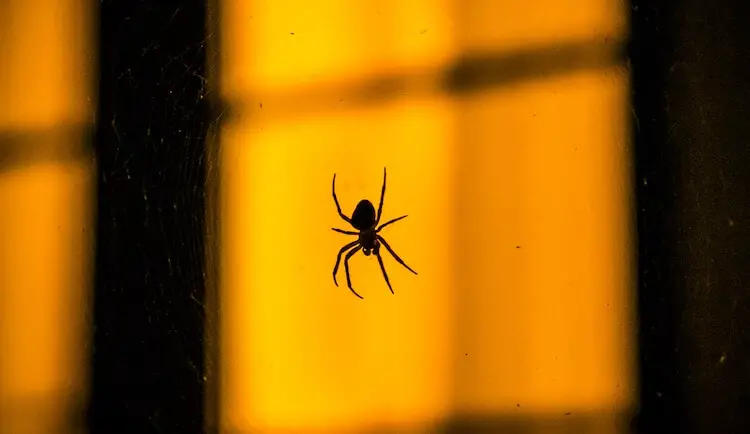
Summary
Spiders eat a diet of different bugs, spiders, moths, butterflies, grasshoppers and locusts. Some are big enough to eat small mammals, reptiles, or small birds too.
House spiders are limited to bugs small enough to make it into the house. They usually eat fleas, ants, flies, roaches and earwigs.
Nearly every species is carnivorous so eats other animals like insects and bugs.
Spiders are an excellent form of pest control both in and out of the house. Take a moment and consider this when deciding whether or not to let one live in your house.
Does this reading make you appreciate these amazing spiders? Let us know in the comments below!

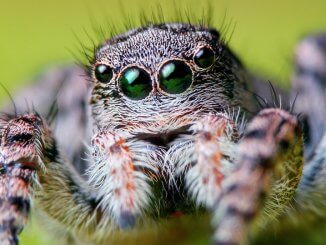
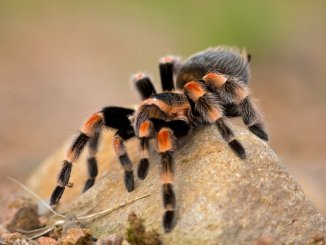

Thank you for the informative piece. My close spider friend, George (a Steatoda grossa), recently came to live indoors and I’m working out what to feed her.
It’s almost 5 am and I’m reading your articles on spiders. Lol I love it!
I spent most of my life afraid of spiders until I saved one. I rescued a tarantula from its owner who was neglecting it and only paid it any attention when showing it off to friends and it hurt me. I love all creatures. I figure they are just as afraid of us as we are of them and I’ve gotten past my fear of spiders.
Also my son and I are Spiderman fans. Lol. I’m glad I came across this site. I’m curious to read more. Thanks 🙂
-Kristin
I have an all black spider living in an old bathtub in my house. He’s about 1.5″ wide and 2″ long. I have no idea what he eats, i have never seen any parts left in the tub like I see under web spiders in the basement. I swear he has been there since August/September. How is that possible? He doesn’t move much and has no web. WFT?
This is not weird at all… depending on the spider species at least. Many spiders do not create webs, or use them differently from what we are accustomed to. Some simply ambush the prey and do not use sticky entrapping webs to get food, and that’s the reason why you don’t see it move much. He probably has a great hunting spots.
A spider has been living in my kitchen for a month now. I haven’t seen any small insects it could be feeding on in this wintertime I am really concerned it could be starving.
That’s what led me here too! I have a wolf spider in my bedroom window, but I’m worried because I’ve very rarely seen any insects in my apartment. He’s only the second spider I’ve seen in the 3 years I’ve lived here, and I don’t want my friend to starve.
I wouldn’t worry! Unless you live in a sterile tank, there’s certainly at least some minuscule insects that you might not notice flying or crawling around. If you want you can try to feed him insects that buy as feeder, but that is not going to be very easy. I think a wolf spider can go for weeks between meals, so even just one prey item can be enough for quite some time.